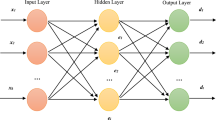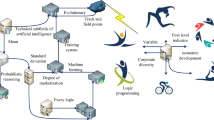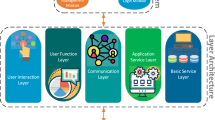Abstract
Sports training effect evaluation has a direct role in improving the effect of sports training. Based on the idea of artificial intelligence and the GABP neural network algorithm, this paper constructs a sports training effect evaluation model based on the GABP neural network. Moreover, this article vectorizes the code based on the sample matrix to improve code conciseness and increase computational efficiency. In addition, this article tests and evaluates the two neural networks that have been optimized for training, and analyzes and compares the nature of the network, topology, and parameter update methods. After testing, it is found that the trained GABP neural network can achieve the ideal high fitting accuracy of training samples and high generalization ability of test samples under the conditions of low memory usage and short training time. The experimental research results show that the model constructed in this paper meets the actual needs of sports training.








Similar content being viewed by others
References
Adhiambo C, Odhiambo M (2012) Social media as a tool of marketing and creating brand awareness, Bus Econ Tour
Ahmeda RAE-D, Shehaba ME, Morsya S, Mekawiea N (2015) Performance study of classification algorithms for consumer online shoppingattitudes and behavior using data mining. In: 5th international conference on communication systems and network technologies.
Bengio Y, Boulanger-Lewandowski N, Pascanu R (2013) Advances in optimizing recurrent networks. In: 2013 IEEE international conference on acoustics, speech and signal processing, Vancouver, pp 8624–8628
Brandt MW, Santa-Clara P (2006) Dynamic portfolio selection by augmenting the asset space. J Financ 61(5):2187–2217
Dahl GE, Sainath TN, Hinton GE (2013) Improving deep neural networks for LVCSR using rectified linear units and dropout. 2013 IEEE international conference on acoustics, speech and signal processing. Vancouver, Canada, pp 8609–8613
Greff K, Srivastava RK, Koutník J et al (2016) LSTM: a search space odyssey. IEEE Trans Neural Netw Learn Syst 28(10):2222–2232
Hochreiter S, Schmidhuber J (1997) Long short-term memory. Neural Comput 9(8):1735–1780
Hu C, Dai L, Yan X et al (2020) Modified NSGA-III for sensor placement in water distribution system. Inf Sci 509:488–500
Kim K (2003) Financial time series forecasting using support vector machines. Neurocomputing 55(1–2):307–319
Leigh W, Modani N, Purvis R et al (2002) Stock market trading rule discovery using technical charting heuristics. Expert Syst Appl 23(2):155–159
Liu Q (2010) Research on stock position dynamic adjustment model. N Financ 2010(11):33–38 ((in Chinese))
Lukac LP, Brorsen BW, Irwin SH (1986) A comparison of twelve technical trading systems with market efficiency implications. Station Bulletin-Department of Agricultural Economics, Purdue University, Agricultural Experiment Station (USA), West Lafayette
Ma N, Wang S, Yu J, Peng Y (2017) A DBN based anomaly targets detector for HSI. In: AOPC 2017: 3D measurement technology for intelligent manufacturing, vol 10458. https://doi.org/10.1117/12.2285766
Ma J, Li Z, Cheng JCP, Ding Y, Lin C, Zherui Xu (2020) Air quality prediction at new stations using spatially transferred bidirectional long short-term memory network. Sci Total Environ 705:135771. https://doi.org/10.1016/j.scitotenv.2019.135771
Maa J, Chenga JCP, ChangqingLina B, Tanc Y, Zhangd J (2019) Improving air quality prediction accuracy at larger temporal resolutions using deep learning and transfer learning techniques. Atmos Environ 214:116885. https://doi.org/10.1016/j.atmosenv.2019.116885
Maknickienė N (2014) Selection of orthogonal investment portfolio using Evolino RNN trading model. Proc Soc Behav Sci 110:1158–1165
Nelson DMQ, Pereira ACM, de Oliveira RA (2017) Stock market’s price movement prediction with LSTM neural networks. In: 2017 international joint conference on neural networks (IJCNN), Anchorage, pp 1419–1426
Pai P, Lin C (2005) A hybrid ARIMA and support vector machines model in stock price forecasting. Omega 33(6):497–505
Pang X, Zhou Y, Wang P et al (2020) An innovative neural network approach for stock market prediction. J Supercomput 76(3):2098–2118
Povinelli RJ (2000) Identifying temporal patterns for characterization and prediction of financial time series events. International workshop on temporal, spatial, and spatio-temporal data mining. Springer, Berlin, pp 46–61
Roondiwala M, Patel H, Varma S (2017) Predicting stock prices using LSTM. Int J Sci Res 6(4):1754–1756
Wang F, Li Y, Liao F et al (2020a) An ensemble learning based prediction strategy for dynamic multi-objective optimization. Appl Soft Comput. https://doi.org/10.1016/j.asoc.2020.106592
Wang F, Li Y, Zhou A, Tang K (2020b) An estimation of distribution algorithm for mixed-variable newsvendor problems. IEEE Trans Evol Comput 24(3):479–493
Yan X, Zhu Z, Hu C et al (2019) Spark-based intelligent parameter inversion method for prestack seismic data. Neural Comput Appl 31(9):4577–4593
Yan X, Hu C, Sheng V (2020) Data-driven pollution source location algorithm in water quality monitoring sensor networks. Int J Bio-Inspir Comput 15(3):171–180
Zeng J, Li F, Liu H, Wen J, Hirokawa S (2016) A restaurant recommender system based on user preference and location in mobile environment. In: Paper presented at the proceedings of the 5th IIAI international congress on advanced applied informatics (IIAI-AAI)
Author information
Authors and Affiliations
Corresponding author
Additional information
Publisher's Note
Springer Nature remains neutral with regard to jurisdictional claims in published maps and institutional affiliations.
Rights and permissions
About this article
Cite this article
Yu, L., He, Y. Evaluation of sports training effect based on GABP neural network and artificial intelligence. J Ambient Intell Human Comput (2021). https://doi.org/10.1007/s12652-021-03094-z
Received:
Accepted:
Published:
DOI: https://doi.org/10.1007/s12652-021-03094-z




